Papers by Lilly Lim-camacho
Journal of Agriculture and Food Research

Community Development Journal
We describe a research-for-development (R4D) strategy developed to address how investments and in... more We describe a research-for-development (R4D) strategy developed to address how investments and interventions in agricultural intensification as a means to achieve community development can be designed to be more socially inclusive and equitable. We draw on results from a 5-year project – Promoting socially inclusive and sustainable agricultural intensification in West Bengal (India) and southern Bangladesh (SIAGI). We reflect on a major pivot in the project’s strategy, from being primarily research-driven to placing community concerns and priorities at the centre with a shift towards Ethical Community Engagement (ECE). This became the foundational framework which guided the definition and undertaking of all subsequent activities – including a rethink of methods and concepts to develop tools and frameworks fit for purpose and local context, and inculcating a culture of reflexivity and mutual learning in the project. We show that creating the conditions for true participation, where p...
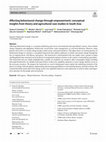
Regional Environmental Change
Affecting behavioural change is a common underlying goal across environmental and agricultural sc... more Affecting behavioural change is a common underlying goal across environmental and agricultural sciences, from climate change mitigation and adaptation, biodiversity conservation, water management, to crop diversification. However, many projects fail to drive or sustain change despite sound science and good intentions. This paper draws on existing theories of behavioural change to construct a conceptual framework that explores pathways to initiate and sustain change through the lens of empowerment, self-efficacy and agency. The framework is demonstrated with case studies from a project in India and Bangladesh that examined social inclusion of marginalised and poor farmers in the context of intensifying agriculture. The framework and case studies highlight that a number of conditions are needed to affect meaningful change including that target beneficiaries are suitably motivated, believe in their own capability and power to enact change and have access to the necessary resources. We ...
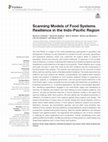
Frontiers in Sustainable Food Systems, 2022
The Indo-Pacific is a region of the world experiencing rapid growth in population and development... more The Indo-Pacific is a region of the world experiencing rapid growth in population and development. However, it is also exposed to a number of social, economic, geopolitical, and biophysical stressors, which may undermine the region's ability to support its population, ensure food security, and sustain livelihoods. In response to the complex suite of stressors, a number of development initiatives and research programs have been established to build resilience in the region's food systems. These initiatives vary in scope and scale, but also in what they mean by the term resilience and the components of the food system they address. This variation has implications for the outcomes of these efforts and how well they match a theoretical ideal of resilience. This review examines how resilience and food systems are defined, conceptualized, and applied within research studies and projects or initiatives on food systems resilience funded or supported by national, regional, or multila...
Food Engineering Innovations Across the Food Supply Chain, 2022
El Sawah, S. (ed.) MODSIM2019, 23rd International Congress on Modelling and Simulation., 2019

Climate change, and its associated climate variability, has significant impacts on the wine indus... more Climate change, and its associated climate variability, has significant impacts on the wine industry and these changes will increasingly be felt along the whole chain of companies that produce, handle, process and market wine. There has been very little work in understanding how wine consumers perceive both the climate change mitigation and adaptation efforts of these companies. This study was conducted to explore Australian wine consumer perceptions towards climate change adaptation and the impacts of climate change on the growing, making and marketing of wine. Data were collected through four focus groups discussions, with a total of of 30 Australian wine consumers. This paper reports the preliminary results of data analysis. Findings revealed that participants are concerned for the production and quality of Australian wines, but their purchase decisions and drinking habits are still guided predominantly by non-environmental factors. They would, however, like to make informed deci...
Environmental Science & Policy, 2021
Syme, G., Hatton MacDonald, D., Fulton, B. and Piantadosi, J. (eds) MODSIM2017, 22nd International Congress on Modelling and Simulation., Dec 3, 2017
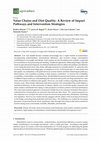
Agriculture, 2019
Low and middle-income countries increasingly face a triple burden of malnutrition encompassing un... more Low and middle-income countries increasingly face a triple burden of malnutrition encompassing undernutrition, micronutrient deficiency, and excessive energy consumption contributing to overweight and obesity. Food systems are also becoming more complex, supported by investments in food processing and retailing. Traditional approaches addressing hunger, typically based on agricultural development, are deemed insufficient alone to address the problem and attention is now being directed to food value chains, although experience is currently limited. To assess the state of science and identify knowledge gaps, an integrative review of the broad topic of value chains and diet quality was undertaken, with particular focus on interventions and their related impact pathways. Interventions were classified according to their primary orientation: to increase the availability, accessibility, or desirability of nutritious food. We identified 24 separate interventions associated with 10 different...

Journal of Environmental Management, 2019
A key reason for undertaking transdisciplinary processes such as knowledge co-production in natur... more A key reason for undertaking transdisciplinary processes such as knowledge co-production in natural resource management is to access and apply different knowledge systems to complex issues. However, the value of coproduction is predominantly framed by academics. They have focused on research design and outcomes in the form of 'science informing policy'. In this paper we build a more inclusive and holistic framing of knowledge coproduction incorporating values of non-academic participants, and values related to the participatory process. Specifically, we examine how knowledge is communicated and deliberated upon and the requirements for this to be done effectively. We draw upon empirical data from interviews with natural resource managers who participated in two case studies of knowledge co-production in Australia and South Africa. Their perspectives are captured in eight evaluation principles that build upon existing evaluation frameworks for public participation. Critically, decision-makers valued science-based outputs not just as salient knowledge sources, but to give legitimacy to their decisions. This need for legitimacy necessitates transparency, fairness and inclusivity in knowledge selection, participation and dialogue within knowledge co-production processes. The practice-based knowledge of decision-makers was important for contextualizing and applying science to specific decision contexts. Another key finding is that communicative competence is central to the process of knowledge coproduction because it enables participants to critically explore and understand the knowledge claims of others.
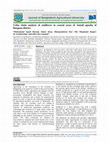
Journal of the Bangladesh Agricultural University, 2019
Sunflower is an important oil seed crop which is well fitted in Robi season of the coastal areas ... more Sunflower is an important oil seed crop which is well fitted in Robi season of the coastal areas of Bangladesh. This study focused on sunflower value chain map, value addition, value chain governance and institutional linkages, and stakeholders and their roles and responsibilities in value adding process of sunflower. A total of 60 respondents were interviewed by using pretested questionnaire. A combination of purposive and snowball sampling techniques was used to select the respondents. Descriptive analytical technique was used to achieve the objectives. The study found that farmers were hardly engaged in sunflower marketing activities. The value chain map comprised of collectors/assemblers, processors, wholesalers and retailers. On an average, total costs (production and marketing) incurred by the farmers were Tk. 11,986.30/acre (100 decimals) of sunflower. Assemblers received a total gross margin of Tk. 588/100 kg of sunflower seeds. At wholesale node the total gross margin was...
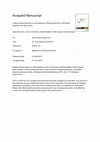
Weather and Climate Extremes, 2018
Climate variability is a key source of livelihood risks faced by smallholder farmers in drier env... more Climate variability is a key source of livelihood risks faced by smallholder farmers in drier environments in many developing countries. Climate information provided on seasonal timescales can sometimes improve agricultural decision-making. However, there are many barriers to the effective dissemination, communication and use of such information on farm and across the value chain. We used a case study in southern India to explore ways of overcoming some of these barriers such as those limiting access to information, and effective communication of probabilistic forecast information. Firstly, we used social network analysis at the village level to identify particular individuals, groups or/and institutions who are central in information networks so as to be able to support them to increase the efficiency, effectiveness, equity and robustness of information transfers. This allowed us to identify potential opportunities and challenges around access, communication and forecast use. Close linking of formal and informal networks appeared to be a common, positive influencing factor. Secondly, we used value chain analysis to assess how pre and post-farm decision-makers could use seasonal climate forecasts (SCF) in their own businesses and how this may propagate up and down the value chain. We found that the motivation for using SCF varied across the value chain and was likely of limited use to smaller, off-farm value chain players who take a short-term adaptive management approach to planning. However, it was seen as having significant potential for larger businesses who take a more strategic approach. This identified a possible risk of increased competitive inequality between businesses of different sizes. Thirdly, we addressed the challenge of translating probabilistic climate forecast information into support for decision making by using decision analysis with intermediaries enabling them to structure clearly problems with embedded climate probabilities. The construction of decision-trees enabled farm The work presented in the paper is part of the Australian Aid Agency for International Development (AusAID) / Department of Foreign Affairs and Trade (DFAT) and CSIRO funded project "Can seasonal climate forecasts improve food security in Indian Ocean Rim countries in a variable and changing climate?". These organisations are thankfully acknowledged. Our sincere thanks go to the farming communities who participated in this activity with enthusiasm and contributed to discussions and provided valuable feedback on the research. We thankfully acknowledge the contributions of our colleagues from the following institutions:










Uploads
Papers by Lilly Lim-camacho